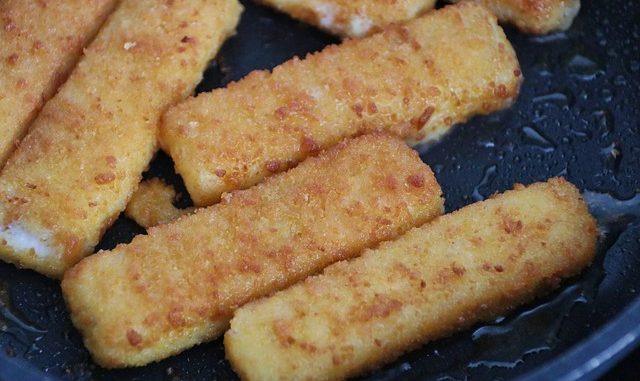
Battered and breaded foods are extremely popular throughout much of the world’s cuisine. They offer the consumer an extra sensory dimension to their food by contributing to its flavour, texture and colour. Here in this article, we uncover some of the science and technology behind batters and the relationship with breading.
Most foods have been coated with some ingredient at some time to create a highly tasty delicious food. You can take your pick from fish, seafoods including crustaceans, poultry especially chicken, cheese, vegetables, and fruits. These battered foods have often been found to varying extent in both high-convenience consumer societies as well as in underdeveloped countries.
Battered, coated and breaded foods are also part of a cultural meme – tempura which is common in Japan, battered soft shell crab in China, chicken nuggets in the USA, fish and chips in the UK. Even now the creation of a batter and bread-crumbing is more art than science. Much of the research in this area is devoted to improving batters and the type of cooking processes that are needed to ensure the crumb remains coated to the food.
Sponge cake batters on the other hand show similar rheology but have a different outcome where they are aerated with chemical interactions causing a rise in the cake.
Understanding the flow behaviour of batters is needed for the design and operation of efficient food-processing equipment.
Brief History
The idea or concept of battering food for frying started sometime in the 60s when home frying became fashionable. In the home, breadcrumbs had been used for centuries as a protective coating but until home frying became possible, the concept of breading your food started to take-off.
At the industrial level, automatic coating and breading equipment started to develop in earnest after the war when whole communities needed to be fed.
The Process Of Battering And Breading
Applying a coating of any sort usually involves three steps or operations; predusting, battering and then breading in that order.
The first step is actually ensuring the fish or chicken to be breaded is completely dry before it is coated. Excessive moisture causes any coating material to become wet and soggy and thus not adhere to the food.
Predusting
The act of coating a food with a fine coating or dusting such as flour to help with the adhesion of a batter. Some chefs call this process dredging. One of its benefits is to reduce the voids caused by entrapment of air pockets between the substrate and the batter during its application. It also helps to improve batter pick-up.
In some food systems, consecutive layers of predusting, battering and then breading helps achieve the desired textural or functional results. The most effective predust is wheat flour. Other predusts tried include native and modified starches, gums such as hydroxypropylmethylcellulose (HPMC) and methylcellulose (MC), proteins include whey protein concentrate, egg albumins etc.
Batter
Quite simply, battering either involves pre-dusting a food with flour or a dry batter mix or applying a liquid mixture for coating the food prior to frying. The liquid mixture is usually made of flour and water to create a thick solution that the food is dipped into. Herbs, salt and pepper are added to provide additional flavour. Its also the base coating for breading.
In most batter systems, the food is passed or conveyed through a special batter applicator, it is then pre-fried to set the batter and allow for the desired frying oil content to occur for the optimum texture and quality (Suderman & Cunningham, 1983).
Breading And Breadcrumbs
Breading is the application of breadcrumbs or other coating to a product and is applied on top of a batter coating. It improves the appearance of the food as well as adding extra layers of texture and flavour. It also adds weight to a product as well as increasing its volume.
Breading can range from simple ingredients such as flour to structured bread crumbs. Most breadcrumb is prepared from cereals which are baked and ground into different sizes ranging from fine to large crumb. The choice of crumb is very much dependent on the consumer and no standard formulation is said to occur – all can vary in terms of size, shape and texture, flavour and colour.
Chicken nuggets for example rely heavily on all sorts of breading to help protect the food during frying as well as contribute flavour.
American breadcrumbs produce a distinct flavoured crust on any food especially after frying. They are probably the closest breading to homemade breadcrumbs in texture and colour. This particular crumb has a two-tone appearance. This is due to the differences between the inner crumb and surface crumb of a loaf of bread. Not too expensive, high durable during handling and frying, it is still one of the most popular bulk bread crumbs on the market.
The Size of Breadcrumbs
The size of breadcrumbs varies between three typical size ranges: small (≤ 250 μm), medium (250 μm-850 μm), and large (> 850 μm) particles.
Partially or fully cooked coated foods are frequently distributed frozen to food service or retail outlets (Loewe, 1990). Whatever the coating it has to stand up to the rigours of transport within the supply chain, rapid and very often highly disruptive changes in temperature as well as the cooking process. Coating quality of many battered and bread crumbed foods are routinely negatively affected by the freezing process and storage in the freezer.
Frying is probably the most aggressive cooking process a battered or breadcrumber product will experience.
Studies on Batter Physical Properties
The functionality, which includes adherence, the appearance and texture of end use of a coated product is very dependent on liquid-solid phase interactions. The rheological performance of the batter is also attributed to a few key features. The batter chemical composition is most likely the key factor that affects its characteristics.
A range of substitutions for wheat flour in a batter have been examined on the rheological properties of batters. These cover fractions of rice flour, native corn starch, modified waxy corn starch, tapioca starch and lupine flour ranging from 26 to 56% of the solid phase and egg levels ranging from 6 to 35% of the liquid phase (Saleh, 2018).
The water holding capacity (WHC) is greatest for lupine flour ranging from 93.9 to 119.3% of various lupine flour percent to egg levels used.
A second measure is the flow behaviour index (n) which ranged in this study from 0.91 to 1.87. When the flow behaviour index is less than 1, the batter is most likely to be shear-thinning These were values greater than a 100% control wheat flour.
The consistency coefficient for a treatment ranged from 0.01 to 0.37 mPa sn; values that were significantly lower than wheat flour (i.e., 5 mPa sn).
The study is also significant because it showed that egg levels had little effect on the rheological properties.
Saleh showed that the changes in the viscoelastic property of the batters and its water holding capacity were the result of changes in both protein and fibre contents as well as physical structure of the batter. This was a compositional change where wheat flour was replaced with a different mixture of starch and flour. In his view, the protein–starch–lipid matrix formation and variation in water absorption kinetics of treatments most probably impacted batter functionality. The increase in pasting with an increase in starch/flour contribution is claimed to have increased contribution of starch in forming a net effect of batter treatments pasting viscosities (Saleh, 2018).
Coating And Adhesion Of Batters And Breadcrumbs
Adhesion of a batter or indeed breadcrumbs is one of the most important physical attributes of any coating. It is a combination of both physical and chemical binding both within the batter as well as with the food. (Suderman and Cunningham, 1979). Coatings are lost during their application, from processing such as frying, in the supply chain, during frozen storage and handling even at the point where it enters the mouth. The other factors are the cooking method, the use of other ingredients in the food, the surface to which it must stick or adhere to, the use of thickeners, the ultra-structure of the skin, holding temperature and use of chemical pre-dips. These are all factors that influence adhesion.
Reducing Oil Absorption During Frying
Oil absorption into food during frying is an issue. the most effective way to reduce excessive oil absorption is to cover the food being fried in an edible film. This is often achieved using methylcellulose (MC) or hydroxypropylmethylcellulose (HPMC) dips. These materials can also be added to breading mixes as part of the breading process or by coating the pieces as a thin film before breading occurs. The dips reduce the amount of oil absorbed and are effective for products such as chicken strips. the most effective method was to add the dry hydrocolloid to the breading formulation. Forming the film before breading reduced its moisture which suggested that migration of moisture from the substrate into the crust was prevented or at least reduced.
Breadcrumb Products
The latest breadcrumb products carry all the credentials expected of a modern food product. Suppliers will readily emphasise their non-GMO credentials, that their products are both gluten-free, dairy free and wheat-free if they can. A good example of such a clean label ingredient are the ‘Plain Bread Crumbs’ produced by Aleia’s Gluten Free Foods (Branford, CT, USA). Not only are these bread crumbs all that is claimed earlier, but they are soy- and corn-free, trans fat-free, of low sodium and kosher. There isn’t much here in the labelling that doesn’t tap into current consumer concerns about products and it marks a real shift in thinking about an ingredient which would normally be considered rather dull and uninspiring.
Typical Compositions:-
Commercial batter: yellow corn flour, bleached wheat flour, leavening, monocalcium phosphate, sugar, salt, corn starch, non-fat milk, dextrose and cellulose gum,
Dense breading: bleached wheat flour, whey, dextrose and soybean oil
Porous breading: breadcrumbs, bleached wheat flour, salt, soybean oil, dextrose, leavening, whey, oleoresin and paprika.
Schnitzel
Chicken pieces especially breast fillets are rolled in dry flour, then dipped in egg batter for breading on both sides whilst pressing the crumbs into the flesh. the meat is then pan fried or deep fried in a pan of very hot oil. the product is always served immediately and relies on the attractive fried smell and crisp texture or enhanced sensory appeal of the product.
Chicken breasts are often battered. The size of the breading particle is significant. In a process where chicken pieces were battered, then breaded and then deep-fat fried, the fried products were analysed for coating adhesion, moisture content and other yield parameters (Maskat & Kerr, 2007). The larger the particle size of the breadcrumb the worse the coating adhesion. The chicken breasts coated using the smaller particle size breadcrumbs had higher moisture in the surface region of the meat as well in the coating.
References
Corey, M. L., Gerdes, D. L., & Grodner, R. M. (1987). Influence of frozen storage and phosphate predips on coating adhesion in breaded fish portions. Journal of Food Science, 52(2), pp. 297-299.
Maskat, M. Y., & Kerr, W. L. (2002). Coating characteristics of fried chicken breasts prepared with different particle size breading. Journal of Food Processing and Preservation, 26(1), pp. 27-38.
Maskat, M. Y., & Kerr, W. L. (2004). Effect of breading particle size on coating adhesion in breaded, fried chicken breasts. Journal of Food Quality, 27(2), pp. 103-113
Saleh, M. (2018) Wheat batter physical properties as influenced by starch/flour types and egg contents. Food Measure 12, pp. 800–807 (Article).
Suderman, D. R., & Cunningham, F. E. (1983). Batter and Breading. AVI Publishing Co., Westport. CT USA.


Leave a Reply